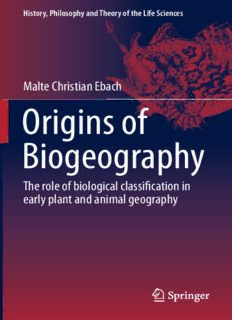
Origins of Biogeography: The role of biological classification in early plant and animal geography PDF
Preview Origins of Biogeography: The role of biological classification in early plant and animal geography
History, Philosophy and Theory of the Life Sciences Malte Christian Ebach Origins of Biogeography The role of biological classifi cation in early plant and animal geography History, Philosophy and Theory of the Life Sciences Volume 13 Editors CharlesT.Wolfe,GhentUniversity,Belgium PhilippeHuneman,IHPST(CNRS/UniversitéParisIPanthéon-Sorbonne),France ThomasA.C.Reydon,LeibnizUniversitätHannover,Germany EditorialBoard MarshallAbrams(UniversityofAlabamaatBirmingham) AndreAriew(Missouri) MinusvanBaalen(UPMC,Paris) DomenicoBertoloniMeli(Indiana) RichardBurian(VirginiaTech) PietroCorsi(EHESS,Paris) FrançoisDuchesneau(UniversitédeMontréal) JohnDupré(Exeter) PaulFarber(OregonState) LisaGannett(SaintMary’sUniversity,Halifax) AndyGardner(Oxford) PaulGriffiths(Sydney) JeanGayon(IHPST,Paris) GuidoGiglioni(WarburgInstitute,London) ThomasHeams(INRA,AgroParisTech,Paris) JamesLennox(Pittsburgh) AnnickLesne(CNRS,UPMC,Paris) TimLewens(Cambridge) EdouardMachery(Pittsburgh) AlexandreMétraux(ArchivesPoincaré,Nancy) HansMetz(Leiden) RobertaMillstein(Davis) StaffanMüller-Wille(Exeter) DominicMurphy(Sydney) FrançoisMunoz(UniversitéMontpellier2) StuartNewman(NewYorkMedicalCollege) FrederikNijhout(Duke) SamirOkasha(Bristol) SusanOyama(CUNY) KevinPadian(Berkeley) DavidQueller(WashingtonUniversity,StLouis) StéphaneSchmitt(SPHERE,CNRS,Paris) PhillipSloan(NotreDame) JacquelineSullivan(WesternUniversity,London,ON) GiuseppeTesta(IFOM-IEA,Milano) J.ScottTurner(Syracuse) DenisWalsh(Toronto) MarcelWeber(Geneva) Moreinformationaboutthisseriesathttp://www.springer.com/series/8916 Malte Christian Ebach Origins of Biogeography The role of biological classification in early plant and animal geography 123 MalteChristianEbach BiologicalEarth&EvironmentalSciences UNSW Kensington,Australia ISSN2211-1948 ISSN2211-1956 (electronic) History,PhilosophyandTheoryoftheLifeSciences ISBN978-94-017-9998-0 ISBN978-94-017-9999-7 (eBook) DOI10.1007/978-94-017-9999-7 LibraryofCongressControlNumber:2015939579 SpringerDordrechtHeidelbergNewYorkLondon ©SpringerScience+BusinessMediaDordrecht2015 Thisworkissubjecttocopyright.AllrightsarereservedbythePublisher,whetherthewholeorpartof thematerialisconcerned,specificallytherightsoftranslation,reprinting,reuseofillustrations,recitation, broadcasting,reproductiononmicrofilmsorinanyotherphysicalway,andtransmissionorinformation storageandretrieval,electronicadaptation,computersoftware,orbysimilarordissimilarmethodology nowknownorhereafterdeveloped. Theuseofgeneraldescriptivenames,registerednames,trademarks,servicemarks,etc.inthispublication doesnotimply,evenintheabsenceofaspecificstatement,thatsuchnamesareexemptfromtherelevant protectivelawsandregulationsandthereforefreeforgeneraluse. Thepublisher,theauthorsandtheeditorsaresafetoassumethattheadviceandinformationinthisbook arebelievedtobetrueandaccurateatthedateofpublication.Neitherthepublishernortheauthorsor theeditorsgiveawarranty,expressorimplied,withrespecttothematerialcontainedhereinorforany errorsoromissionsthatmayhavebeenmade. Printedonacid-freepaper SpringerScience+Business MediaB.V.DordrechtispartofSpringerScience+Business Media(www. springer.com) Drawinglinesona map justto showI’m there – BearCage/G.m.b.H (TheStranglers,1980) Prologue Biogeography meansdifferentthingstodifferentpeopledepending, ofcourse, upontheir outlookandupontheirbiases(Ball1975:407) There is no scientific field more contentious, fragmented and misunderstood as biogeography. The confusion as to what biogeography is and how one defines it has presented both scientists and historians of science with a convoluted history. Do we define biogeography by ideas or by what biogeographers actually do? Many histories of biogeography (plant and animal geography), written by both historiansofscienceandscientists,areaboutideas,mostlyaboutthedevelopmentof evolutionarytheories.Otherhistoriesconcentrateontheresultsofbiogeographical practice,suchastheoriesderivedfromstudyingdisjunctdistributions.Fewhistories, however, focus on what biogeographers actually do and fewer still are aimed at scientists. In this book I present a history of scientific practice, a science historiography, namely the history of methods used by plant and animal geographerbetween the 1770sandthe1890s.Ihavedonethisbyrereadingthehistoricalscientificliterature, ratherthanengagingintheliteraturewrittenbyhistoriansofscience.Thepointofa “sciencehistoriography”istopresentthetwenty-first-centurybiogeographerswitha historytheycanunderstandandrelatetointermsofhowtheypractisetheirscience.I amascientistandapractitionerofbiogeographyandsystematics,andIhavewritten thisbookprimarilyforthe sciencecommunity.Historiansofsciencemayuse this book as a secondary resource and as an opportunity to study the viewpoint of a twenty-first-centuryscientist. The term biogeographywas coined late in the nineteenth century separately in GermanandEnglish,atatimewhenplantandanimalgeographywerebothfirmly establishedbutpractisedseparately.Thecallstounifyplantandanimalgeography within a “biogeography” were made at a time when early forms of ecology (vegetationgeography)andtaxonomywerebattlingforanaturalclassification.This booklooksathowthe practice ofclassification hasshapedearly plantand animal geographybeforethe1890s. vii viii Prologue This book will also examine how scientific specialisation has favoured certain forms of practice over others. For instance, the botanical geography of Augustin PyramusdeCandollewasinpartadmonishedbycertainplantgeographersduetoits apparentuseof“artificial”regions,ratherthan“natural”vegetableformations:the formerrequiredtrainingintaxonomy,geographyandEarthhistory,whilethelatter wasahistorical,basedonmeasurement,andthereforeeasiertodo.Classification,a formofacademicspecialisation,influencedthepracticeofregionalisation,suchas the mappingof taxonomicgroupsof plants and vegetationtypes (e.g. woodlands, savannahs). OriginsofBiogeographyaimstoexplainthemultipleoriginsofthenineteenth- century plant and animal geography (later called biogeography), to show that it wasinfluencedbymethodsandpracticesfromotherfieldsandtodemonstratethat the plant and animal geography practised in 1800 is vastly different from that in 1900 and 2000. I will also show that scientific practice and specialisation, rather than scientific ideas or theories, drove plant and geography between 1777 and 1900. A history of scientific practice may help a practicing twenty-first-century biogeographerunderstandtherelevanceandimpactofclassificationonthehistory oftheirfield.Focusingonthepracticeofclassification,ratherthanonevolutionary or developmental theories or syntheses, presents a different history of plant and animalgeographyaltogether. Another aspect to this book is to challenge our current understanding of how biogeographywaspractisedbyengagingscientistswithahistorythattheymaynot otherwiseread.Recenthistoriesofbiogeography,writtenbyscientists,aresteeped inthesearchforthefoundersofideasoractsasatool,onethatAustralianhistorian andphilosopherofscienceJohnS.Wilkinsbelieves: ::: has only an instrumental value in science. If it can be used to advance particular scientific claims then it is valuable; elsewise it is simply vapid, irrelevant or a waste of timeandresources,accordingtoscientists.(Wilkins2014,p.281) Iwillattempttodebunkseveralofthesehistories,namelythatplantandanimal geographieshaveclear-cutorigins: OnecanbeginwithAlexandervonHumboldt(1769–1859),whoisoftenrecognizedasthe father of plant biogeography [:::] [Wallace] was a key founder of zoogeography [:::] Overthenext100yearstheconceptsofevolutionandtheroleofdispersalingeographic patternswereexpanded,buttherewaslittlerealchangeinmethodology.(Wenetal.2013: 913) Moreover,Ichallengetheideathatevolutionarytheorywastheexpectedoutcome ofthenineteenth-centuryplantandanimalgeography: From the beginnings of evolutionary thought in the early to mid-nineteenth century, geographicpatternsfiguredprominentlybothaschallengestoevolutionaryexplanationand byprovidingsupportfordescentwithmodification.(Donoghue2013,p.76) Thepracticeofthenineteenth-centuryplantandanimalgeographywasmorean attempttounderstandtheworldusingtaxonomicorvegetationclassification,rather thanthemorepopularstanceofnaturalistsstrivingforaunifiedsynthesis. Prologue ix This volume is written primarily for scientists. The length is short, and the message concise. Each chapter may be read individually,every citation is written outinfullandthereareplentyofhelpfulfootnotes,areferencesectionandanindex. I havealso includeda glossaryofhistoricalfigures,allowingfora comprehensive discussionwithoutthedistractionofintroductions. Thetextisdividedintosix partsthatcoverthelate eighteenthandmuchofthe nineteenthcentury.Chapter1introducesbiogeography,anoverviewofthehistories written by scientists and historians and the role of specialisation in the history of biogeography.Chapter2focusesontheroleofdistributionaltheoriesonthepractice of animal and plant biogeography. Chapter 3 follows the development of early plant geography and the interactions between three of its practitioners, Augustin PyramusdeCandolle,AlexandervonHumboldtandFriedrichStromeyer,andhow this had shaped the classification of plant geography. Chapter 4 follows the split betweentaxonomicandvegetationplantgeographers,theriseofecologicalanimal geographyandtherivalrybetweenearlyecologistsandevolutionistsovertheroleof naturalclassification.Chapters5and6willfocusonregionalisation,theapplication ofanareaclassificationplantandanimalbiogeography.Theendsectionofthebook containsaglossaryofhistoricalfiguresmentioninthisbook(Biosketches)–ahandy guideforscientists wishing to knowmore aboutpastpractitionersfeaturedin this book. References Ball,I.R.(1975).Natureandformulationofbiogeographicalhypotheses.SystematicZoology,24, 407–430. Donoghue, M. J. (2013). Historical biogeography. In J. B.Losos (Ed.), The Princeton guide to evolution(pp.75–81).Princeton:PrincetonUniversityPress. Wen,J.,Ree,R.H.,Ickert-Bond,S.M.,Nie,Z.,&Funk,V.(2013).Biogeography:Wheredowe gofromhere?Taxon,62,912–927. Wilkins, J. S. (2014). Book review, do species exist? Principles of taxonomic classification. SystematicBiology,63,280–281.
Description: